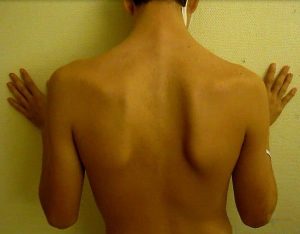 Scapular dyskinesia, also known as irregular shoulder blade movement, is a disorder that impairs the biomechanics of the shoulder joint. This disorder can cause pain, reduced movement, and poor sports performance. In this article, we will look at the causes, symptoms, and treatment options for scapular dyskinesia, as well as how to prevent it.
Scapular dyskinesia, also known as irregular shoulder blade movement, is a disorder that impairs the biomechanics of the shoulder joint. This disorder can cause pain, reduced movement, and poor sports performance. In this article, we will look at the causes, symptoms, and treatment options for scapular dyskinesia, as well as how to prevent it.
Understanding Scapular Dyskinesia:
Scapular dyskinesia is a deviation from the usual position or motion of the scapula during coupled scapula-humeral movements. It occurs in a wide range of shoulder joint traumas, and is frequently caused by injuries that block or disorganize activation patterns in scapular stabilizing muscles. It may exacerbate the functional impairment caused by shoulder injury by changing the typical scapular role during coupled scapula-humeral motions. Scapular dyskinesia appears to be a general reaction to shoulder dysfunction, as no specific pattern of dyskinesia is linked to a specific shoulder pathology.
The Primary Causes of Scapular Dyskinesia
Understanding the underlying causes of scapular dyskinesia is critical for prevention and treatment. Several variables may lead to this condition:
- Muscle Imbalances: To move properly, the muscles around the scapula, such as the serratus anterior, trapezius, and rhomboids, must act together. Weakness or stiffness in these muscles can impair scapular mobility.
- Injuries: Shoulder injuries, such as rotator cuff tears, labral injuries, or clavicle fractures, can affect the scapula’s natural motion.
- Posture Issues: Poor posture, particularly rounded shoulders or forward head posture, causes unnecessary stress on the shoulder girdle, resulting in incorrect scapular alignment.
- Overuse: Repetitive overhead activities, such as swimming, tennis, and weightlifting, can strain the shoulder muscles and cause dyskinesia over time.
- Neurological Conditions: Nerve injuries, such as long thoracic nerve palsy, can weaken the serratus anterior muscle and impair scapular control.
Recognize the symptoms:
Scapular dyskinesia frequently manifests with modest symptoms that develop if left untreated. Key indicators to look for include:
- Pain around the Shoulder Blade: Discomfort is usually felt in the upper back or around the shoulder blade, particularly during arm motions.
- Limited Range of Motion: Activities that require lifting the arm overhead or reaching behind the back may be difficult or unpleasant.
- Visible Abnormal Movement: During arm motions, the scapula may “wing” or move unevenly in comparison to the opposite side.
- Muscle Fatigue or Weakness: Even with moderate exertion, the muscles in the shoulder and upper back may feel fatigued.
It’s crucial to remember that scapular dyskinesia is frequently a secondary disorder, which means it develops as a result of other underlying problems such as shoulder injuries or bad posture. Early detection and action are critical to avoiding additional issues.
SICK Scapula
The abbreviation SICK refers to the features seen in this syndrome (scapular malposition, inferior medial border prominence, coracoid discomfort and malposition, and scapular movement dyskinesia). This recently identified overuse muscle fatigue condition is another source of shoulder pain in throwing athletes who come with dead arm symptoms.1 The defining feature of this syndrome is asymmetric malposition of the scapula in the dominant throwing shoulder, which appears on examination as if one shoulder is lower than another.
Treatment Options:
While treatment varies depending on the degree and underlying reason, the primary goal is to restore normal scapular motion and address contributory variables. The key approaches include:
Physical Therapy: Physical therapy is the most effective treatment for scapular dyskinesia. A professional physiotherapist can examine individual movement patterns and provide a tailored training regimen.
Postural Corrections: Improving posture is a simple yet effective method. Ergonomic changes, such as utilizing a supportive chair or altering the height of the computer screen, can help to relieve pressure on the shoulders and neck. Practicing proper posture during daily tasks also aids with scapular alignment.
Medical interventions: In extreme cases corticosteroid injections or surgical procedures may be explored, but they are uncommon and usually reserved for cases with structural problems or persistent pain.
Tips for Preventing Scapular Dyskinesia
Scapular dyskinesia is typically easier to prevent than treat. To maintain healthy shoulder mechanics and lower your risk, incorporate the following practices into daily routine:
- Exercises: That target the rotator cuff and scapular stabilizers should be performed on a regular basis to strengthen the shoulders. Push-ups, rows, and shoulder presses can improve muscle balance.
- Maintain Good Posture: Be aware of your posture throughout the day. Avoid slouching by sitting and standing with your shoulders back and chest open.
- Warm up properly: Before beginning any physical activity, perform dynamic stretches and shoulder-specific exercises to prepare your muscles and joints.
- Avoid Overuse: To prevent repetitive strain injuries, balance training with rest. If you participate in sports, make sure your technique is good and take rests to avoid overworking your shoulder.
- Stay Active: A sedentary lifestyle can lead to muscular imbalances and poor posture. Incorporate regular physical activity into your daily routine to keep your muscles healthy and flexible.
Scapular dyskinesia can be a difficult condition, particularly for athletes and people who have physically demanding occupations. However, with correct knowledge, prevention, and prompt action, this illness can be effectively managed and even prevented. Understanding the causes, symptoms, and treatment choices will help you maintain optimal shoulder health and functionality. If you have recurrent shoulder pain, obvious anomalies in scapular movement, or trouble doing daily duties, you should consult a healthcare expert. Early detection can help prevent the illness from deteriorating and increase your chances of complete recovery
